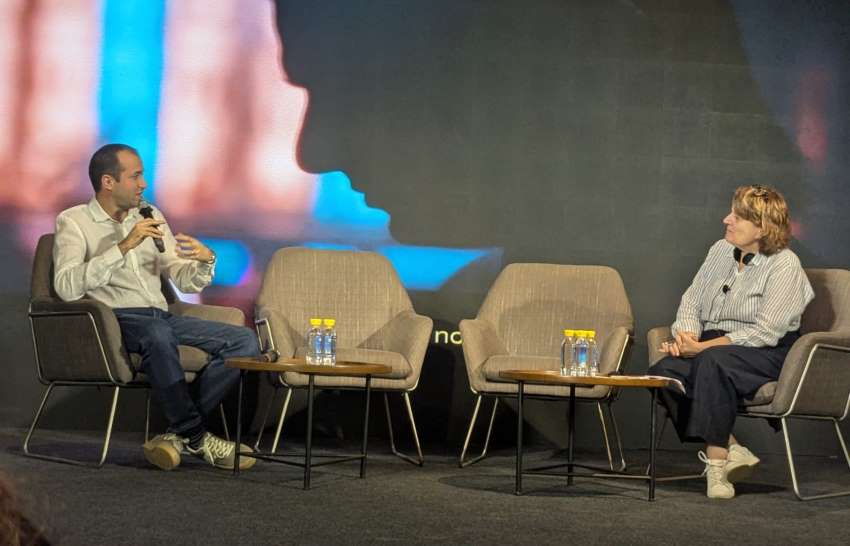FW
The 33rd Annual General Meeting [AGM] of the Export Promotion Council was held today at New Delhi. Ravi K. Passi, Chairman EPCH while addressing the AGM informed that with the active support of the Council, exporting community performed very well with respect to exports from the Country which was Rs. 23,029.36 crores in 2017-18 and reached to the tune of Rs. 26,590.25 in 2018-19 crores registering an impressive growth of 15.46% over the previous year.
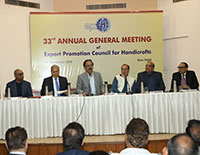 The 33rd Annual General Meeting [AGM] of the Export Promotion Council was held today at New Delhi. Ravi K. Passi, Chairman EPCH while addressing the AGM informed that with the active support of the Council, exporting community performed very well with respect to exports from the Country which was Rs. 23,029.36 crores in 2017-18 and reached to the tune of Rs. 26,590.25 in 2018-19 crores registering an impressive growth of 15.46% over the previous year.
The 33rd Annual General Meeting [AGM] of the Export Promotion Council was held today at New Delhi. Ravi K. Passi, Chairman EPCH while addressing the AGM informed that with the active support of the Council, exporting community performed very well with respect to exports from the Country which was Rs. 23,029.36 crores in 2017-18 and reached to the tune of Rs. 26,590.25 in 2018-19 crores registering an impressive growth of 15.46% over the previous year.
Passi further informed about multifarious activities related to marketing, product and design development, skilling, compliance and other initiatives undertaken by EPCH during 2018-19 which included participation in International fairs within India and in the overseas markets, organizing informative seminars all across craft clusters, providing handholding to entrepreneurs, exporters and artisans and Council’s active engagement with MSME’s SFURTI programme in Northern Eastern Region.
He informed that Council also represented various issues pertaining to GST, MEIS benefits and the range of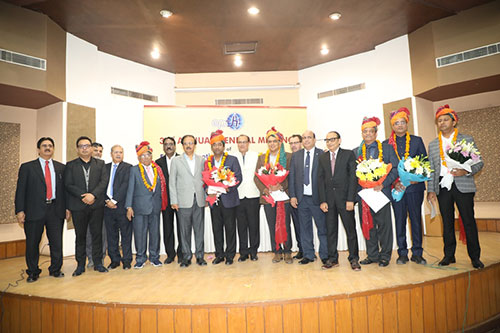 other issues affecting handicrafts sector at the highest level including Ministry of Textiles, Ministry of Commerce & Industry and Ministry of Finance.
other issues affecting handicrafts sector at the highest level including Ministry of Textiles, Ministry of Commerce & Industry and Ministry of Finance.
With an objective to offer avenues for technological upgradation, skill development and marketing opportunities, EPCH set up Handicrafts Productivity Centre and Testing Laboratory at Jaipur, upgraded the Saharanpur Common Facility Centre with latest and modern technology machines elaborated Shri Passi.
Rakesh Kumar, Director GeneralEPCH while speaking on the occasion informed the members present in the meeting about Council’s PAN India reach and active participation of the prominent exporters from various crafts pockets in development, promotion and growth of exports of Handicrafts. He further informed the House about the tremendous increase of participation in IHGF Delhi Fair (Autumn/Spring) as well as footfall of overseas buyers in IHGF Delhi Fair in recent IHGFs. The DG-EPCH further informed the House about the council’s future plans to actively engage the social media platforms to increase its reach within India as well across the globe and also providing backward and forward linkages for overall growth of handicrafts sector.
During 33rd AGM six members of the Committee of Administration were also elected. The newly elected members includeRaj Kumar Malhotra of M/s Asian Handicrafts Pvt. Ltd., Gurgaon from Northern Region, HansrajBaheti of M/s Thar Art Exports, Jodhpur and LekhrajMaheshwari of M/s Rajasthan Handloom & Handicrafts Industries, Jaipur from North West Region, Nabeel Ahmad of M/s Nawab Regency, Moradabd, Kamal Soni of M/s Vallabh Metal Inc., Moradabd and Sharad Kumar Bansal of M/s Bansal Impex, Moradabad are elected from Central Region informed Rakesh Kumar, DG – EPCH.
The Handicrafts exports during the eight months of current financial year from April to November, 2019-20 is Rs. 17,292.68 crores registering a growth of over 2.72% over the same period in last year.
From 11th to 13th March 2020, the latest edition of CHIC March 2020 takes place in Shanghai and paves the way to the most coveted fashion market in the world.
One of Asia's largest trade fair for fashion and lifestyle presents around 1,000 Chinese and international exhibitors on an enlarged 145,000 m² in the National Exhibition & Convention Center, who will be efficiently networked with the expected 100,000 visitors. CHIC offers a comprehensive upgrade for 2020. For the first time, all exhibition segments have been integrated as separate show-in shows and have been sharply defined with new names. In the international area CHIC WORLDWIDE brands from Italy, France, Germany, Korea, etc. presents themselves and their new collections. Individual exhibitors come from Spain, Poland, Switzerland, Turkey, Singapore, Vietnam, India etc.
The Strategic marketing measures provide even more targeted support for international exhibitors: cooperation with influential Chinese key opinion leaders (KOLs) are being intensified, the cooperation with the most important sales platforms is being expanded, and the VIP matching with invitations of key accounts has been increased. The business seminars CIHC TALKS will be expanded internationally in March 2020; the CHIC SHOWS show the relevant trends on the Chinese market.
"The focus on recycled fibers at the Spring/Summer 2021 Kingpins New York edition, once again highlighted the importance of recycling in fashion. As Ozge Ozsoy, Marketing Chief of Bossa noted recently, fashion industry’s interest in recycling is growing with brands taking many steps to lessen their negative impact on the environment"
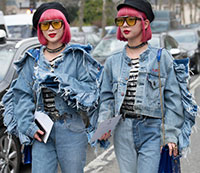 The focus on recycled fibers at the Spring/Summer 2021 Kingpins New York edition, once again highlighted the importance of recycling in fashion. As Ozge Ozsoy, Marketing Chief of Bossa noted recently, fashion industry’s interest in recycling is growing with brands taking many steps to lessen their negative impact on the environment.
The focus on recycled fibers at the Spring/Summer 2021 Kingpins New York edition, once again highlighted the importance of recycling in fashion. As Ozge Ozsoy, Marketing Chief of Bossa noted recently, fashion industry’s interest in recycling is growing with brands taking many steps to lessen their negative impact on the environment.
New collection from recycled jeans
Bossa became the first textile company to produce 100 per cent recycled fabric through its Re-Set collection, which it launched in 2006. The mill currently makes around 11 per cent of its clothes from recycled products and plans to increase this to 25 per cent. The mill recently launched a project where it collects used jeans from consumers to recycle into new products. These recycled jeans are a part of the mill’s new Future Denim collection made from a range of 100 per cent sustainable fabrics including organic cotton, recycled cotton recycled polyester, Eco-T400 and Refibra, and combined with Bossa’s water-saving blue dyeing process.
Fibers from recycled PET bottles
Like Bossa, Pakistan-based Artistic Milliners’ makes fabrics from recycled yarns.
The mill’s portfolio of recycled fibers includes pre-consumer recycled cotton, post-consumer recycled cotton, industrial waste and branded fibers like Tencel’s Refibra, Roica by Asahi Kasei and Unifi’s Repreve and Ocean Repreve. For Spring/Summer 2021, the company launched new R&D platforms, bio-vision and circular blue, to support zero waste design product development for fiber technologies and water and energy usage. Its most popular recycled alternatives include post-consumer waste and recycled polyester. Its Repreve fiber is recycled from PET bottles. The company plans to recycle around 20 billion plastic bottles by 2020 to make this fiber. 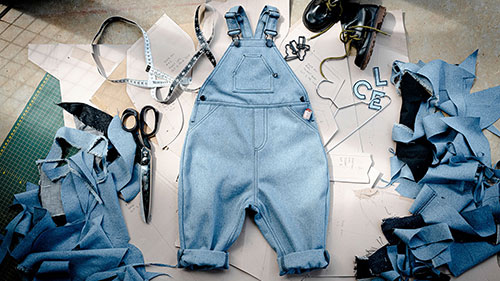
Fabrics made from Repreve or pre-consumer recycled cotton with Recycled Claim Standard and Global Recycled Standard certifications also dominate the portfolio of Prosperity Textile. At Kingpins, the mill presented many inspiring ideas on recycling, like the Indigo Renew line, which is upcycled from the indigo cotton yarn wastes produced at dyeing mills. Since the yarns are already dyed, no further indigo dyeing is needed to create the signature blue tone. The company also introduced fabrics made from the newly launched Lyra Ecomade and T400 Ecomade fibers made recycled materials.
Pakistan-based Soorty mill uses Repreve in a variety of stretch fabrications. The company’s Repreve range complements its other recycling initiatives, including a range of denims made with organic cotton and 20 percent post-consumer recycled cotton or industrial recycled cotton.
Expanding recycling cotton program
Mexico-based Global Denim also launched its Spring/Summer 2021 range made from Repreve. The brand soon plans to launch its recycling cotton program-Ecoloop on a broader scale. Through this program, the mill creates new fabrics with recycled cotton yarn sourced from post-consumer jeans and its own floor scraps and textiles from its commercial partners, launched last year as a small conceptual line. Approximately 20 to 25 per cent of the mill’s collection for Spring/Summer 2021 has 10 to 15 per cent recycled cotton content in its makeup.
Another denim mill that priortises recycling is: Artistic Fabric & Garment Industries (AFGI). In 2016, the company’s in-house shredding plant was certified under the GRS to process post-consumer waste jeans into new fibers. This allows it to transform discarded jeans into new yarns, fabrics and jeans. At Kingspins, it presented a ‘100 percent sustainable jean’ made with 70 percent post-industrial recycled cotton and 30 percent post-consumer recycled cotton.
Increasing the recycled content in denims
Though the US market is yet to adopt entirely recycled jean, many American labels are now considering using more recycled content in their denim. Currently, denims sold in the US contain only 5 per cent recycled content as these cost more than the regular jeans. Brands are challenged by justifying the higher cost for a product that consumers still correlate to be made by ‘used’ goods.
Thus, the use of recycled fibers in the denim fabric process is still in its infancy. To create more awareness about the concept, brands will have to work on educating shoppers. For this, the suppliers can organise educational platforms in collaboration with retailers. However, they also need to ensure that they provide sold and trustable information about their products to the consumers.
Portugal’s textile and clothing exports increased about two per cent in September 2019 compared to the same month last year. However, the country’s textile and clothing exports have fallen 0.9 per cent since the beginning of the year. Knitwear exports fell 2.7 per cent. Exports of cotton raw materials, including yarns and fabrics, fell 9.8 per cent. The fall in exports, combined with the 3.1 per cent increase in imports of textiles and clothing, has led to a deterioration of the trade balance of the sector. Even so, the balance remains quite positive, with a coverage rate of 121 per cent.
Turkey, Canada, India, Trinidad and Tobago and Vietnam are Portugal’s main non-EU destinations. As a part of strategic plan for the textile and apparel sector, Portugal has made pointed commitments in sustainability and digitization to keep the country competitive. The increase of the production scale assisted by digital technologies allows flexibility in the Portuguese textile business model. Flexibility is among Portugal’s key competitive advantages. Besides that, the country is one of the worldwide leaders of the private label, in what is an essential differentiator in the textile market. Portugal is bringing its competitive offerings to light at a time when sourcing has been upset over changing trade relations, and companies are looking for new places to manufacture product.
Colombian companies are planning to enter Spain. One is Studio F. This fashion retailer will combine four channels in its development in the market: directly operated stores, concessions, multibrand and e-commerce. The first directly operated stores will arrive at the end of 2020, and the company is already looking for opportunities both in shopping malls and on the main street, working with real estate agents. In three years the company plans to have a store network of forty corners and 18 directly operated stores in Spain. Instead of competing with Spanish retailer giants like Zara or Mango, Studio F will bet on positioning itself in Spain in a higher segment and focusing on denim as a differential element. Studio F does not plan to adapt its collections to European styles or its patterns to European physiognomy. The company will land in the Spanish market with its women’s wear offer.
Leather goods specialist Cueros Vélez has similar plans. In recent years, it has diversified with the launch of fashion and footwear collections for men and women. Until now, Latin American fashion companies mostly focused on international expansion within the region. For their approach to the European market, the natural first step is Spain, which is close to their culture and language.
Europe is the preferred destination for international elite shoppers. France is the most popular, followed by the UK and Italy, reveals a study by Global Blue. For the elite, international shopping is heavily weighted towards the high-end, with almost 75 per cent of their spend being made in the luxury or hard luxury categories. Around 25 per cent of the total spend is made in the lifestyle, premium and affordable luxury categories. The top ten per cent of elite shoppers are responsible for 36 per cent of the total elite tax free spend. International elite shoppers come primarily come from five key regions/countries, Greater China, Southeast Asia the Gulf states, the US and Russia.
International elite shoppers – or the top 0.5 per cent of tax free spenders – account for 17 per cent of global tax free retail income. These shoppers travel on an average about three times a year, over approximately 15 days. While Europe accounts for a higher footfall, the country which receives the highest spend per individual elite shopper is Singapore. The UK is Europe’s highest benefactor, with department stores attracting a large share of the total spend. Singapore’s status as the country that attracts the highest spend from elite shoppers is fuelled by luxury watches and jewelry purchasing.
"Brands are investing in digitisation and mapping real-time data. They are also developing demand-led models based on consumer insights, which helps fashion brands cut down on over-production. However, this shift towards digitisation is being adopted by only those brands which can afford to invest in such technologies. Smaller players are yet to digitally capture and leverage such consumer insights"
 One can no longer overlook the huge environmental impact of the highly-fragmented garment supply chain. For the last few years, industry leaders have been putting in efforts to increase the visibility of entire garment supply chain. Often small and mid-sized companies operate in a massive supply chain which makes it impossible for them to know the source of their raw materials, their manufacturers and suppliers running their factories.
One can no longer overlook the huge environmental impact of the highly-fragmented garment supply chain. For the last few years, industry leaders have been putting in efforts to increase the visibility of entire garment supply chain. Often small and mid-sized companies operate in a massive supply chain which makes it impossible for them to know the source of their raw materials, their manufacturers and suppliers running their factories.
Brands invest in digitisation and real time data
The garment industry not only aims to address the absence of standardised sourcing but also maintain a traceable and transparent supply chain. Currently, there is a wide disconnect between suppliers, manufacturers and consumers resulting in about 73 per cent of used garments ending up in landfills or being incinerated.
To handle this, brands are investing in digitisation and mapping real-time data. They are also developing demand-led models based on consumer insights, which helps fashion brands cut down on over-production. However, this shift towards digitisation is being adopted by only those brands which can afford to invest in such technologies. Smaller players are yet to digitally capture and leverage such consumer insights.
Besides skill, capability and integrity, brands require a substantial amount of capital to incorporate a sustainable procurement process. Currently, only a few major brands have initiated green reforms on a large scale. A case in point is H&M which plans to achieve to 100 per cent sustainable cotton by 2020. The company addresses this challenge by involving its customers in creating a completely recycled clothing line. This gives their brand a sense of association with the brand’s green initiatives. Another global brand, Adidas, is ramping up its initiative to use only recycled polyester in its shoes by 2024.
Short-term investments for long-term benefits
Though sustainable sourcing involves extra initial costs, these are offset by the long-term benefits of reducing waste and minimising unsold merchandise. Brands like Zara and Bershka are sourcing smaller batches of material to gauge their popularity before deciding on the volume of the production. Brands are also implementing demand-based merchandise using digital marketing tools and AI to make their supply chain agile and flexible.
The complexity in supply chains is being reduced through nearshoring. They are increasingly working with garment manufacturers in locations closer to their consumer-base to cut down lead times and counter rising labor costs in traditional outsourcing destinations. For instance, US brands now prefer Mexico as a garment manufacturing hub rather than China.
Sustainability leads to increased transparency
Today, customers aim to make informed decisions about purchases. They avoid making purchases that would adversely impact the environment. Sustainable brands are now aiming for a greater level of transparency by investing in RFID and blockchain technologies. They are likely to share the list of suppliers with customers besides informing them about the ecological footprint of the product.
To consolidate operations, brands are reducing the number of suppliers they work with. One of the key differentiating factors deciding these partnerships include the social and sustainability scores of suppliers which is leading manufacturers to refine their own sustainability practices.
The garment supply chain can be transformed by making sustainable sourcing an integral part of a company’s culture. To be known as sustainable, a brand needs to redesign its corporate culture, create accountability and foster cross-functional collaboration. A thoughtful product development, co-investment and long-term planning, along with robust measurement and management of performance, will help the garment industry achieve a sustainable supply chain.
The first phase of the Sino-US trade agreement has been greatly helpful for the textile and apparel sector. Tariffs for products worth $250 billion will sustain at 25 per cent and the tariff rate for goods worth $120 billion will be reduced from 15 per cent to 7.5 per cent.
Export orders for textiles and apparels are likely to grow with the downward adjustment of tariffs but the growth may be limited. Not all the additional tariffs are being removed. For the goods worth $250 billion covering chemical fibers and some textiles, the additional tariff is maintained at 25 per cent. Tariffs have not been totally removed, especially in textiles and apparels made of chemical fiber.
The first phase of the Sino-US economic and trade agreement covers nine chapters including preamble, intellectual property, technology transfer, food and agricultural products, financial services, exchange rates and transparency, expanding trade, bilateral assessments and dispute settlement, and final clauses. The two sides have also reached an agreement that the US will fulfill its relevant commitment to phase out the imposition of additional tariffs on Chinese products. The optimism lies in the improvement of mindsets and an expectation of a suspension of the Sino-US trade war.
Unilever has rolled out an initiative to improve the livelihoods of a million apparel workers in Bangladesh and enhance their overall health and well-being. Unilever is the largest fast moving consumer goods company in Bangladesh. Specifically the aim is to ensure good health and well-being for all ages, ensure availability and sustainable management of water and sanitation for all, and ensure sustainable consumption and production patterns. In addition, Unilever will make its products available inside factory premises at special prices exclusively for workers.
The garment sector, being the bulwark of economic growth for Bangladesh, has been making a crucial contribution of approximately 11 per cent to the gross domestic product. With more than 4.4 million workers employed in the sector, about 60.8 per cent of whom are women, the growth of the garment industry has far reaching implications for the economy.
Unilever is one of the world’s leading consumer goods companies, making and selling around 400 brands in more than 190 countries. Thirteen of the world’s top 50 brands are owned by Unilever. Its business activities span a complex, global value chain. Its products are distributed to 25 million retailers. Unilever is also the second largest advertiser in the world.
The Renewal Workshop’s circular model for renewal and re-commerce not only drives sales and customer engagement for brands but also has significant environmental impact. Based in the US, The Renewal Workshop is a provider of circular solutions for apparel and textile brands. The company is organised around the idea that businesses have multiple responsibilities for generating positive, lasting value.
The apparel industry’s take-make-waste cycle is turning circular with the rise of re-commerce. This is changing the game for brands who see their products resold on third-party sites. The Renewal Workshop enables brands to be a driving force in this transition, with a complete solution that not only manages the collection, renewal, and quality of a brand’s damaged or used garments, but also the back-end of the brand’s own re-commerce site. This allows brands to engage directly with customers in their own branded second-sale channel. The Renewal Workshop operates a zero-waste circular system that recovers the full value out of what has already been produced. Brand partners receive impact data on the amount of water, carbon, and chemicals that are saved through their partnership. To date, over two hundred thousand pounds of apparel have been diverted from waste in this system.


